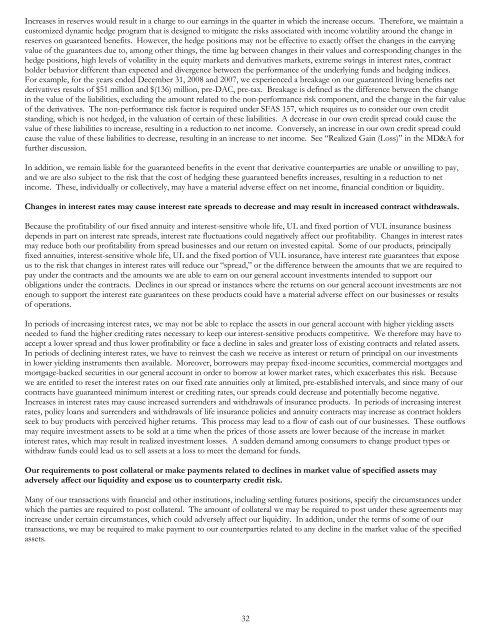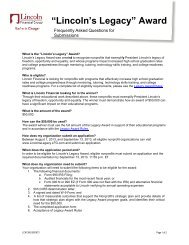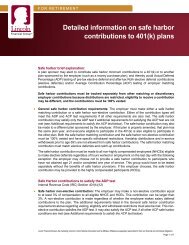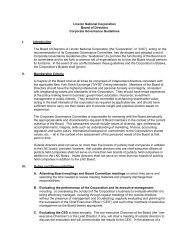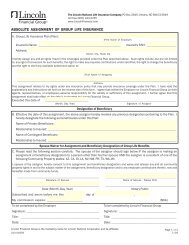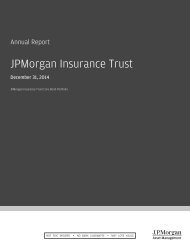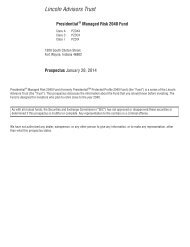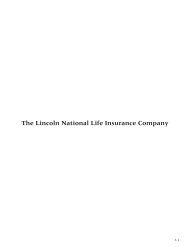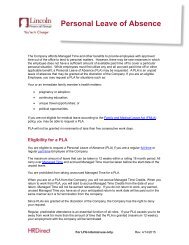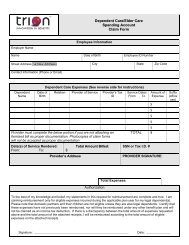2008 Annual Report to Shareholders - Lincoln Financial Group
2008 Annual Report to Shareholders - Lincoln Financial Group
2008 Annual Report to Shareholders - Lincoln Financial Group
You also want an ePaper? Increase the reach of your titles
YUMPU automatically turns print PDFs into web optimized ePapers that Google loves.
Increases in reserves would result in a charge <strong>to</strong> our earnings in the quarter in which the increase occurs. Therefore, we maintain a<br />
cus<strong>to</strong>mized dynamic hedge program that is designed <strong>to</strong> mitigate the risks associated with income volatility around the change in<br />
reserves on guaranteed benefits. However, the hedge positions may not be effective <strong>to</strong> exactly offset the changes in the carrying<br />
value of the guarantees due <strong>to</strong>, among other things, the time lag between changes in their values and corresponding changes in the<br />
hedge positions, high levels of volatility in the equity markets and derivatives markets, extreme swings in interest rates, contract<br />
holder behavior different than expected and divergence between the performance of the underlying funds and hedging indices.<br />
For example, for the years ended December 31, <strong>2008</strong> and 2007, we experienced a breakage on our guaranteed living benefits net<br />
derivatives results of $51 million and $(136) million, pre-DAC, pre-tax. Breakage is defined as the difference between the change<br />
in the value of the liabilities, excluding the amount related <strong>to</strong> the non-performance risk component, and the change in the fair value<br />
of the derivatives. The non-performance risk fac<strong>to</strong>r is required under SFAS 157, which requires us <strong>to</strong> consider our own credit<br />
standing, which is not hedged, in the valuation of certain of these liabilities. A decrease in our own credit spread could cause the<br />
value of these liabilities <strong>to</strong> increase, resulting in a reduction <strong>to</strong> net income. Conversely, an increase in our own credit spread could<br />
cause the value of these liabilities <strong>to</strong> decrease, resulting in an increase <strong>to</strong> net income. See “Realized Gain (Loss)” in the MD&A for<br />
further discussion.<br />
In addition, we remain liable for the guaranteed benefits in the event that derivative counterparties are unable or unwilling <strong>to</strong> pay,<br />
and we are also subject <strong>to</strong> the risk that the cost of hedging these guaranteed benefits increases, resulting in a reduction <strong>to</strong> net<br />
income. These, individually or collectively, may have a material adverse effect on net income, financial condition or liquidity.<br />
Changes in interest rates may cause interest rate spreads <strong>to</strong> decrease and may result in increased contract withdrawals.<br />
Because the profitability of our fixed annuity and interest-sensitive whole life, UL and fixed portion of VUL insurance business<br />
depends in part on interest rate spreads, interest rate fluctuations could negatively affect our profitability. Changes in interest rates<br />
may reduce both our profitability from spread businesses and our return on invested capital. Some of our products, principally<br />
fixed annuities, interest-sensitive whole life, UL and the fixed portion of VUL insurance, have interest rate guarantees that expose<br />
us <strong>to</strong> the risk that changes in interest rates will reduce our “spread,” or the difference between the amounts that we are required <strong>to</strong><br />
pay under the contracts and the amounts we are able <strong>to</strong> earn on our general account investments intended <strong>to</strong> support our<br />
obligations under the contracts. Declines in our spread or instances where the returns on our general account investments are not<br />
enough <strong>to</strong> support the interest rate guarantees on these products could have a material adverse effect on our businesses or results<br />
of operations.<br />
In periods of increasing interest rates, we may not be able <strong>to</strong> replace the assets in our general account with higher yielding assets<br />
needed <strong>to</strong> fund the higher crediting rates necessary <strong>to</strong> keep our interest-sensitive products competitive. We therefore may have <strong>to</strong><br />
accept a lower spread and thus lower profitability or face a decline in sales and greater loss of existing contracts and related assets.<br />
In periods of declining interest rates, we have <strong>to</strong> reinvest the cash we receive as interest or return of principal on our investments<br />
in lower yielding instruments then available. Moreover, borrowers may prepay fixed-income securities, commercial mortgages and<br />
mortgage-backed securities in our general account in order <strong>to</strong> borrow at lower market rates, which exacerbates this risk. Because<br />
we are entitled <strong>to</strong> reset the interest rates on our fixed rate annuities only at limited, pre-established intervals, and since many of our<br />
contracts have guaranteed minimum interest or crediting rates, our spreads could decrease and potentially become negative.<br />
Increases in interest rates may cause increased surrenders and withdrawals of insurance products. In periods of increasing interest<br />
rates, policy loans and surrenders and withdrawals of life insurance policies and annuity contracts may increase as contract holders<br />
seek <strong>to</strong> buy products with perceived higher returns. This process may lead <strong>to</strong> a flow of cash out of our businesses. These outflows<br />
may require investment assets <strong>to</strong> be sold at a time when the prices of those assets are lower because of the increase in market<br />
interest rates, which may result in realized investment losses. A sudden demand among consumers <strong>to</strong> change product types or<br />
withdraw funds could lead us <strong>to</strong> sell assets at a loss <strong>to</strong> meet the demand for funds.<br />
Our requirements <strong>to</strong> post collateral or make payments related <strong>to</strong> declines in market value of specified assets may<br />
adversely affect our liquidity and expose us <strong>to</strong> counterparty credit risk.<br />
Many of our transactions with financial and other institutions, including settling futures positions, specify the circumstances under<br />
which the parties are required <strong>to</strong> post collateral. The amount of collateral we may be required <strong>to</strong> post under these agreements may<br />
increase under certain circumstances, which could adversely affect our liquidity. In addition, under the terms of some of our<br />
transactions, we may be required <strong>to</strong> make payment <strong>to</strong> our counterparties related <strong>to</strong> any decline in the market value of the specified<br />
assets.<br />
32


